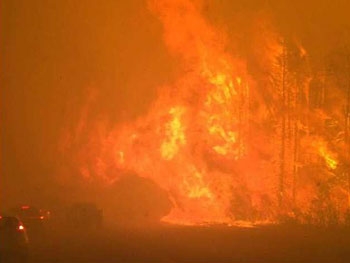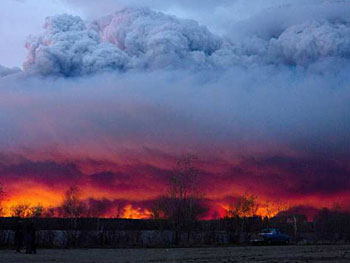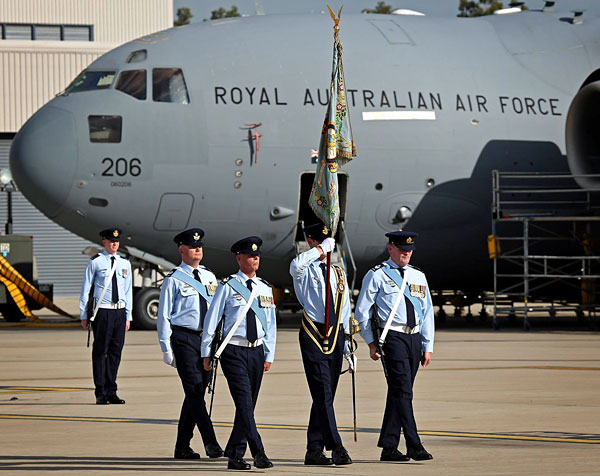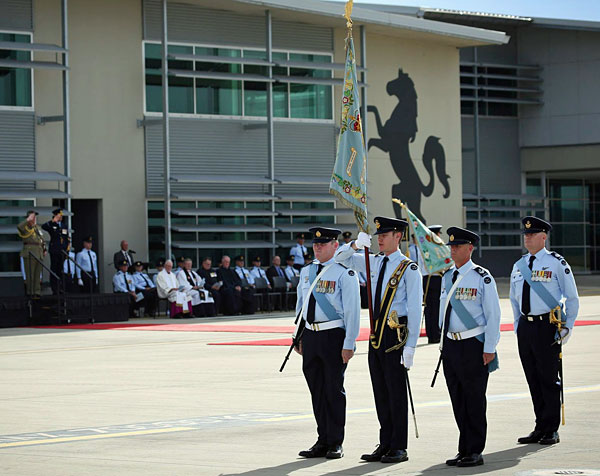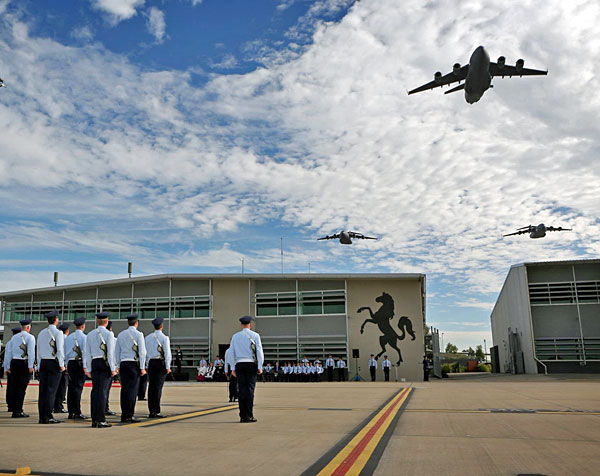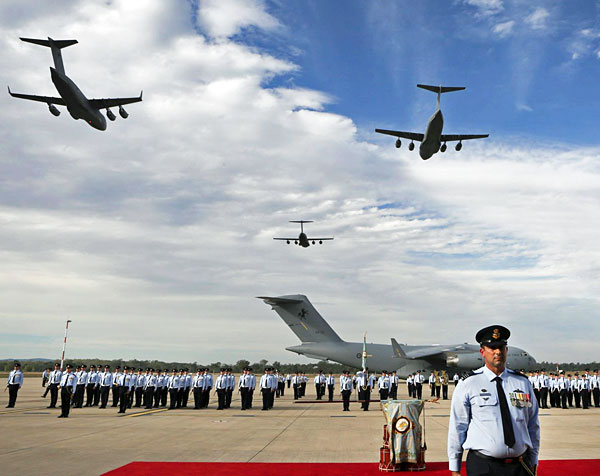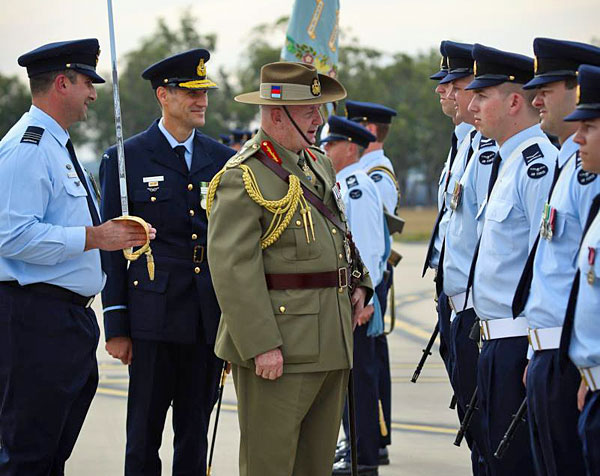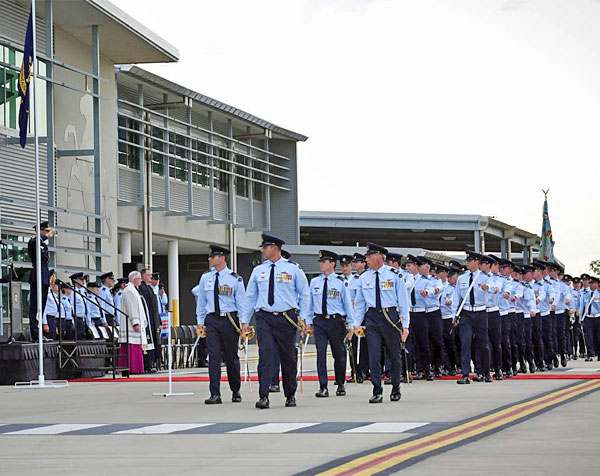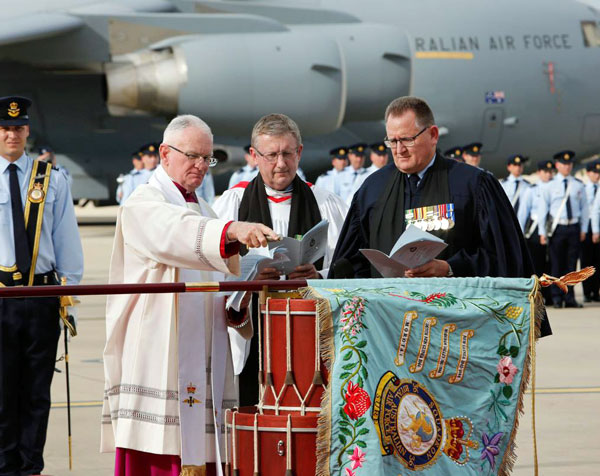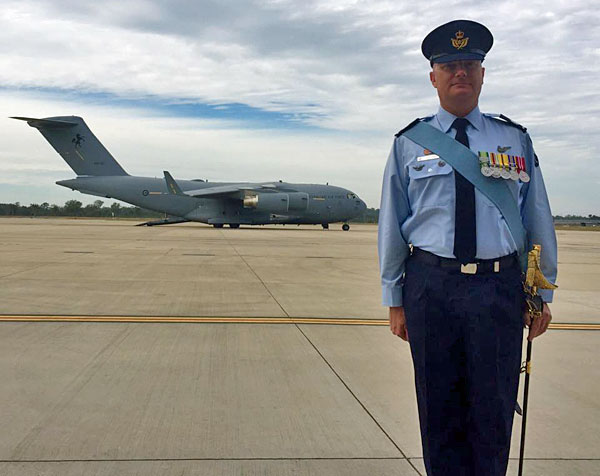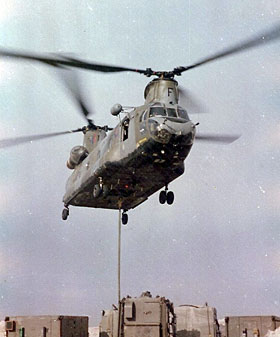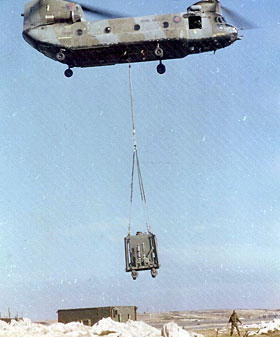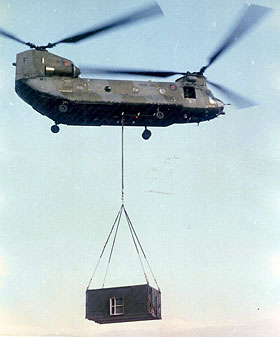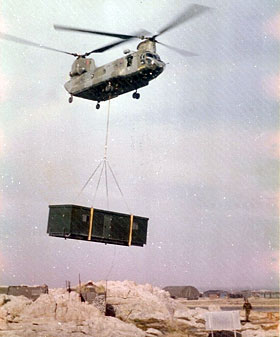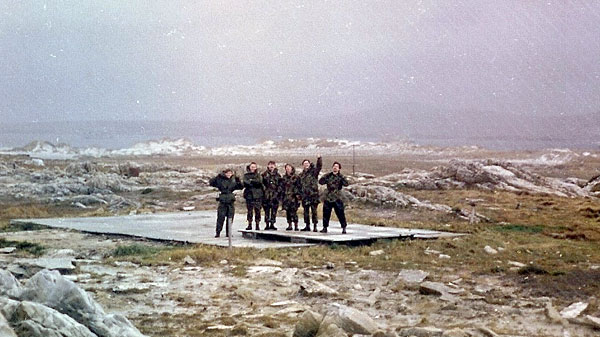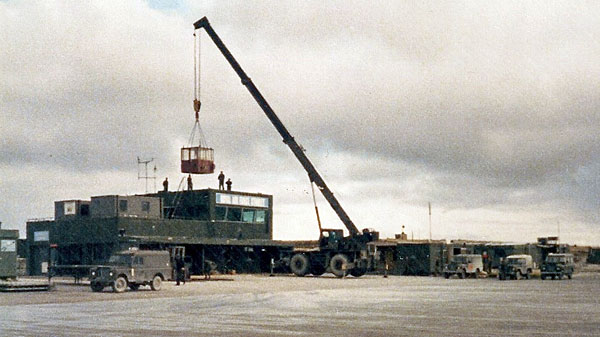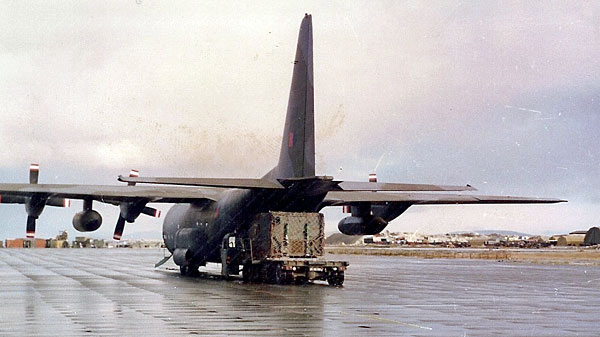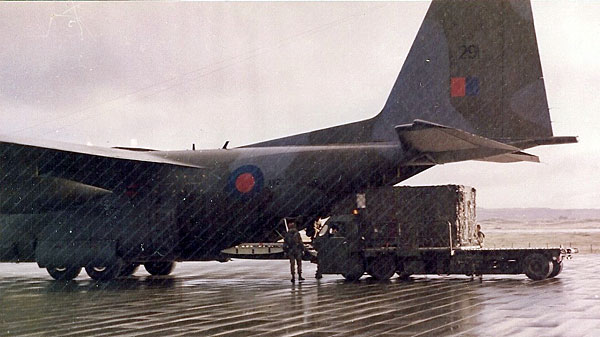
50 Years on and UKMAMS Regains Squadron Status!
(Never underestimate the magical powers of the phoenix!)
(Never underestimate the magical powers of the phoenix!)
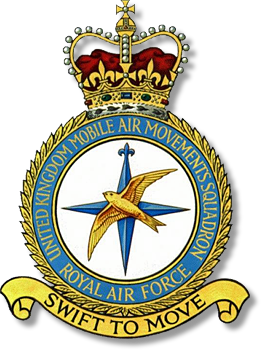
At a dinner to celebrate 25 years of the RAF MAMS and Movements Squadrons Association last Saturday, it was announced by Wing Commander Nick Huntley, OC 1 Air Mobility Wing, that the current MAMS elements of 1 AMW will be renamed UKMAMS.
The unit was initially formed as a Section at RAF Abingdon in 1958 and then on 1st May 1966 squadron status and the title United Kingdom Mobile Air Movements Squadron (UKMAMS) was attained. On 10th November 2006, UKMAMS lost its 40 year old squadron status when it was absorbed into the newly created 1 Air Mobility Wing
As of 1st June 2016, 1 Air Mobility Wing will include the Operational Support Squadron (OSS) and the United Kingdom Mobile Air Movements Squadron (UKMAMS).
The unit was initially formed as a Section at RAF Abingdon in 1958 and then on 1st May 1966 squadron status and the title United Kingdom Mobile Air Movements Squadron (UKMAMS) was attained. On 10th November 2006, UKMAMS lost its 40 year old squadron status when it was absorbed into the newly created 1 Air Mobility Wing
As of 1st June 2016, 1 Air Mobility Wing will include the Operational Support Squadron (OSS) and the United Kingdom Mobile Air Movements Squadron (UKMAMS).
In addition to many other responsibilities, OSS provides logistical support to UKMAMS and an additional flight dedicated to the Permanent Air Movements Detachments (PAMDs) at six locations worldwide.
Within UKMAMS there will be 5 mobile flights providing dedicated manpower to meet operational and exercise tasking, both contingent and enduring.
Within UKMAMS there will be 5 mobile flights providing dedicated manpower to meet operational and exercise tasking, both contingent and enduring.
From: David Powell, Princes Risborough
Subject: Re: UKMAMS OBA OBB #042916
Hi Tony,
Thank you for the latest OBA newsletter; I really enjoyed the Op Corporate narratives!
We are just back from an excellent Great Rail Journeys holiday based on Lake Como in Northern Italy. That this holiday was a very smooth experience was in no small part due to our group having a very professional tour manager, namely one (Warrant Officer) Martin Jones ex UKMAMS and 1 AMW!
Photo attached of Martin waiting for his charges to sort themselves out to board the first leg of the tour at St Pancras, a Eurostar hop to Paris.
Hopefully, Martin will now get himself signed up for the OBA.
Best wishes
David Powell
F Team UKMAMS 1967-69
Subject: Re: UKMAMS OBA OBB #042916
Hi Tony,
Thank you for the latest OBA newsletter; I really enjoyed the Op Corporate narratives!
We are just back from an excellent Great Rail Journeys holiday based on Lake Como in Northern Italy. That this holiday was a very smooth experience was in no small part due to our group having a very professional tour manager, namely one (Warrant Officer) Martin Jones ex UKMAMS and 1 AMW!
Photo attached of Martin waiting for his charges to sort themselves out to board the first leg of the tour at St Pancras, a Eurostar hop to Paris.
Hopefully, Martin will now get himself signed up for the OBA.
Best wishes
David Powell
F Team UKMAMS 1967-69
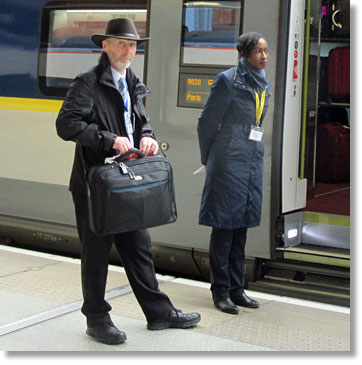
RCAF provides much needed assistance for Fort McMurray
Earlier this month the 60,000 residents of Fort McMurray in Alberta's Oil Sands area had to be evacuated as a massive wild fire advanced on the town.
Here is an RCAF CC-130J Loadmaster giving a pre-flight briefing to oil rig workers who were being evacuated.
Here is an RCAF CC-130J Loadmaster giving a pre-flight briefing to oil rig workers who were being evacuated.
From: Ian Stacey, Sleepy Hollow, IL
Subject: Junior Officer Mishaps
Hi Tony,
I know I have missed the issue on Junior Officer Mishaps, but just now, while I was reading that issue, it reminded me of something I put together a few year ago called "A lesson in Humility" and I think that it fits the subject well:
This is a true story. Not all of us have such striking life lessons and I am thankful that this happened to me. Although at the time, “wild horses” would not have persuaded me to the truth; as I grow older, I find myself telling and re-telling this incident as a joke against myself and also because, at the time, I advanced several years in experience in a matter of seconds. It is a lesson that I have never forgotten.
Subject: Junior Officer Mishaps
Hi Tony,
I know I have missed the issue on Junior Officer Mishaps, but just now, while I was reading that issue, it reminded me of something I put together a few year ago called "A lesson in Humility" and I think that it fits the subject well:
This is a true story. Not all of us have such striking life lessons and I am thankful that this happened to me. Although at the time, “wild horses” would not have persuaded me to the truth; as I grow older, I find myself telling and re-telling this incident as a joke against myself and also because, at the time, I advanced several years in experience in a matter of seconds. It is a lesson that I have never forgotten.
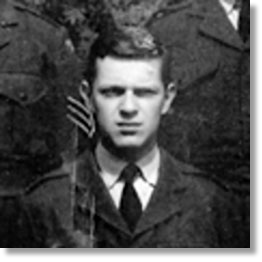
It is fairly common knowledge that the true “day-to-day” running of any military organization, regardless of what outsiders may think or perceive, is carried out by that shrewd and experienced sage - the Senior NCO. Staff Officers may make policy, Junior Officers think that they give orders but nothing actually gets done without the involvement of the SNCO. The Royal Air Force is no exception to this reality.
Following a serious injury in the Gulf that kept me in hospital for over a year, I was posted to RAF Abingdon. By now I had reached the even more exulted rank of “Flying Officer”, I had been commissioned for three years and I was twenty-one years old! My SD cap was faded by the heat of the tropical sun and there were no flies on me! I’d been around a bit and I knew about those wily SNCO’s.
Prior to my transfer to UKMAMS, I spent a year as a shift Movements Officer on the Station Movements Flight and it was here that the subject incident occurred.
I had been put on a special detachment at a nearby RAF Station for several days. This required me to sign out a Land Rover from the Station MT Section each day of the detachment. Now the MT Sergeant was a particularly hairy-arsed sage with no great love for junior officers who were still wet behind the ears. This, I should have sensed if I had any sense in me.
On the first day I signed out a vehicle that was rife with problems, the brakes were poor, the wipers had a fault etc. etc. In the evening, upon returning the vehicle, I sought out the MT Sergeant and in no uncertain terms and with the full authority of my exulted rank I told him what I thought about his sorry vehicle. Furthermore, I insisted, I did not expect to receive the same vehicle on the next day or there would be trouble for him! With due deference and a sort of choked expression the MT Sergeant assured me that I would not get the same beast tomorrow.
Early next morning, I was astonished to perceive that the vehicle waiting for me was the same one as yesterday. How did I know this? Well of course the RAF puts reference marks on everything that moves and a lot of things that don’t move as well. The reference mark on the side of this particular Land Rover was the same one as yesterday, you couldn’t fool me. This Sergeant wasn’t going to get away with this!
I stormed into the MT Sergeant's office and in a loud voice indicated my displeasure at his failure to comply with my orders. He looked genuinely surprised and assured me that this was indeed a different vehicle from yesterday. Did he think I was stupid? “Come outside with me”, I told him, “and I’ll show you how I know you’re trying to pull the wool over my eyes.”
We walked over to the vehicle where I indignantly pointed to the tell-tale reference mark just above the left wheel, “See Sergeant - there it is - TP25!”
With a quiet smile the MT Sergeant looked at me and said “Yes Sir, tyre pressure 25."
Prior to my transfer to UKMAMS, I spent a year as a shift Movements Officer on the Station Movements Flight and it was here that the subject incident occurred.
I had been put on a special detachment at a nearby RAF Station for several days. This required me to sign out a Land Rover from the Station MT Section each day of the detachment. Now the MT Sergeant was a particularly hairy-arsed sage with no great love for junior officers who were still wet behind the ears. This, I should have sensed if I had any sense in me.
On the first day I signed out a vehicle that was rife with problems, the brakes were poor, the wipers had a fault etc. etc. In the evening, upon returning the vehicle, I sought out the MT Sergeant and in no uncertain terms and with the full authority of my exulted rank I told him what I thought about his sorry vehicle. Furthermore, I insisted, I did not expect to receive the same vehicle on the next day or there would be trouble for him! With due deference and a sort of choked expression the MT Sergeant assured me that I would not get the same beast tomorrow.
Early next morning, I was astonished to perceive that the vehicle waiting for me was the same one as yesterday. How did I know this? Well of course the RAF puts reference marks on everything that moves and a lot of things that don’t move as well. The reference mark on the side of this particular Land Rover was the same one as yesterday, you couldn’t fool me. This Sergeant wasn’t going to get away with this!
I stormed into the MT Sergeant's office and in a loud voice indicated my displeasure at his failure to comply with my orders. He looked genuinely surprised and assured me that this was indeed a different vehicle from yesterday. Did he think I was stupid? “Come outside with me”, I told him, “and I’ll show you how I know you’re trying to pull the wool over my eyes.”
We walked over to the vehicle where I indignantly pointed to the tell-tale reference mark just above the left wheel, “See Sergeant - there it is - TP25!”
With a quiet smile the MT Sergeant looked at me and said “Yes Sir, tyre pressure 25."
I was commissioned at the ripe old age of 18 as “ ACTING Pilot Officer” and it was with this exulted rank that I was first posted to Flying Training School at RAF Syerston. God knows what any of the SNCO’s at that station must have thought when they saw me, I don’t think I even had to shave each day at that time! The fact that years later, in my early twenty’s, I was known amongst other things as “baby face” will give you a clue as to my appearance.
I should have started learning then how unimportant I was in comparison to those experienced men. God even tried to give me a fair start when one day I was smartly put in my place with an admonishment from the Station Warrant Officer after having failed to notice and return his salute from the far side of the parade square, “Excuse me Sir, but I was saluting you!” yelled at 1,000 decibels for all to hear.
Government economics dictated that I was not to stay at the front end of the airplane. (It was cheaper to change me than the undercarriage every third landing!) So it was that I found myself 18 months later as Equipment Officer on 5004 Airfield Construction Squadron at Khormaksar in the Gulf of Aden. Here God tried again, on my behalf, to impress upon me the insignificance of my position in comparison to those men who got things done. Every morning the Equipment Flight Sergeant placed a large pile of papers and forms on my desk, each one was marked with a red cross on it. “Please Sir, sign each piece of paper next to the red cross, but DON’T bother to read them!”
I should have started learning then how unimportant I was in comparison to those experienced men. God even tried to give me a fair start when one day I was smartly put in my place with an admonishment from the Station Warrant Officer after having failed to notice and return his salute from the far side of the parade square, “Excuse me Sir, but I was saluting you!” yelled at 1,000 decibels for all to hear.
Government economics dictated that I was not to stay at the front end of the airplane. (It was cheaper to change me than the undercarriage every third landing!) So it was that I found myself 18 months later as Equipment Officer on 5004 Airfield Construction Squadron at Khormaksar in the Gulf of Aden. Here God tried again, on my behalf, to impress upon me the insignificance of my position in comparison to those men who got things done. Every morning the Equipment Flight Sergeant placed a large pile of papers and forms on my desk, each one was marked with a red cross on it. “Please Sir, sign each piece of paper next to the red cross, but DON’T bother to read them!”
RNZAF Crew Top Performers at International Military Exercise
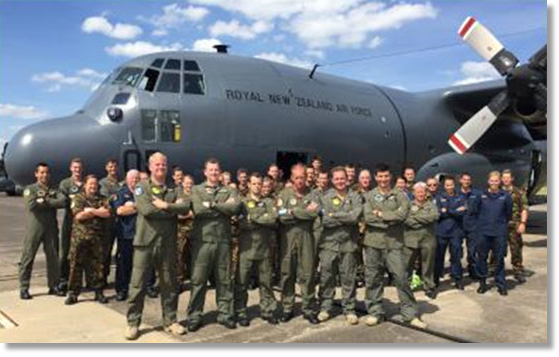
A C-130 Hercules crew from the Royal New Zealand Air Force (RNZAF) was judged the top performing crew in a multi-national exercise held in the United States.
Seventeen crews from four countries (Australia, New Zealand, Sweden, and the United States) took part in Exercise Green Flag, in Little Rock, Arkansas from 15-25 April 2016.
The RNZAF crew from 40 Squadron, led by aircraft captain Flight Lieutenant (FTLT) Alex Tredrea, took out the “Top Cat” award as best overall crew, based on criteria such as accuracy of bomb drops, time on target, planning and tactics used, and ability to react to short-notice changes.
Exercise Green Flag is an operational preparedness training exercise aimed at providing realistic experience of working with other militaries in a combat environment. In this case the RNZAF crew were in support of the US 101st Airborne Division fighting a simulated ground war.
Seventeen crews from four countries (Australia, New Zealand, Sweden, and the United States) took part in Exercise Green Flag, in Little Rock, Arkansas from 15-25 April 2016.
The RNZAF crew from 40 Squadron, led by aircraft captain Flight Lieutenant (FTLT) Alex Tredrea, took out the “Top Cat” award as best overall crew, based on criteria such as accuracy of bomb drops, time on target, planning and tactics used, and ability to react to short-notice changes.
Exercise Green Flag is an operational preparedness training exercise aimed at providing realistic experience of working with other militaries in a combat environment. In this case the RNZAF crew were in support of the US 101st Airborne Division fighting a simulated ground war.
Detachment Commander, Squadron Leader (SQNLDR) Leigh Foster said the exercise required the RNZAF crew to conduct airdrops delivering food, water, and weapons and also undertake missions to deliver vehicles, large weaponry, ammunition and personnel to the army to ensure positions were attained and maintained.
“The feedback was that the flexibility and operational focus our crew displayed was outstanding,” SQNLDR Foster said.
The RNZAF participate in annual routine training exercises such as Green Flag to build and maintain the skills and capabilities required in a real-world situation.
scoop.co.nz
“The feedback was that the flexibility and operational focus our crew displayed was outstanding,” SQNLDR Foster said.
The RNZAF participate in annual routine training exercises such as Green Flag to build and maintain the skills and capabilities required in a real-world situation.
scoop.co.nz
From: Andy Holliday, St. Just, Cornwall
Subject: Re: UKMAMS OBA OBB #042916
Hi Tony,
Thanks for the last newsletter, it was good to see the other accounts of Op Corporate from Pete, Jim and Neale. It did make me realise that I owe Alan Kilpatrick an apology for calling him John... the risks of not captioning pictures until months after the event.
I would also like to thank three others without whom our job would have been much harder. Wg Cdr Chris Swaithes (OC UKMAMS) was a constant source of support and our cheerleader with HQ 38 Gp. Wg Cdr Mike Barham (OC Tactical Supply Wing) and Gp Capt Bill Girdwood (I think Senior Logistics Officer at HQ Land Forces Falkland Islands) were very influential in ensuring our voice was heard at HQ LFFI. I suspect that without their intervention we would have waited much longer for our ACHE to come ashore from the ship.
Thanks again Tony,
Best Wishes,
Andy
Subject: Re: UKMAMS OBA OBB #042916
Hi Tony,
Thanks for the last newsletter, it was good to see the other accounts of Op Corporate from Pete, Jim and Neale. It did make me realise that I owe Alan Kilpatrick an apology for calling him John... the risks of not captioning pictures until months after the event.
I would also like to thank three others without whom our job would have been much harder. Wg Cdr Chris Swaithes (OC UKMAMS) was a constant source of support and our cheerleader with HQ 38 Gp. Wg Cdr Mike Barham (OC Tactical Supply Wing) and Gp Capt Bill Girdwood (I think Senior Logistics Officer at HQ Land Forces Falkland Islands) were very influential in ensuring our voice was heard at HQ LFFI. I suspect that without their intervention we would have waited much longer for our ACHE to come ashore from the ship.
Thanks again Tony,
Best Wishes,
Andy
RAF logisticians rock!
Group Captain Polly Perkins, Head of Establishment at RAF Brize Norton, explains why.
“From rotors-turning-refuelling of helicopters in the desert, to recovery of a damaged aircraft, even delivering hot three course meals in the arctic, Royal Air Force logisticians excel supporting UK military operations across the globe. That’s because RAF personnel think end-to-end to pre-empt challenges, we consider and mitigate second and third order consequences, and we do it all with efficient use of resources. Every individual, from the most senior to the most junior, understands that their role is to support and deliver - and, in this modern era, they do so with propriety, innovation and professionalism.
“Trained to work in challenging terrain and austere locations, RAF logisticians establish end-to-end supply chains across the world and harness local resource to support the vast breadth of the Royal Air Force’s highly technical and complex weapon systems.
“From rotors-turning-refuelling of helicopters in the desert, to recovery of a damaged aircraft, even delivering hot three course meals in the arctic, Royal Air Force logisticians excel supporting UK military operations across the globe. That’s because RAF personnel think end-to-end to pre-empt challenges, we consider and mitigate second and third order consequences, and we do it all with efficient use of resources. Every individual, from the most senior to the most junior, understands that their role is to support and deliver - and, in this modern era, they do so with propriety, innovation and professionalism.
“Trained to work in challenging terrain and austere locations, RAF logisticians establish end-to-end supply chains across the world and harness local resource to support the vast breadth of the Royal Air Force’s highly technical and complex weapon systems.
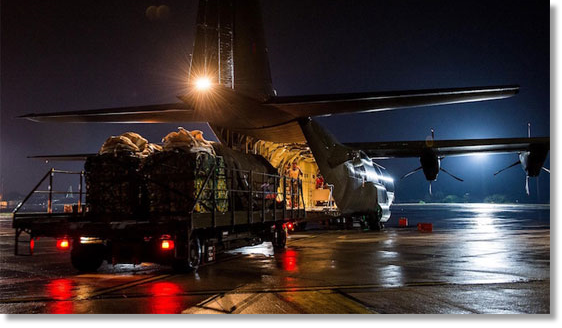
“They understand the role and importance of personnel to deliver capability, and ensure that every individual arrives fully equipped to conduct their duties from day one. To achieve this, they work across boundaries utilising teamwork and building relationships within the Service, with their civil servant and contractor colleagues as well as Host Nations and multi-national counterparts.
“The Logistics Squadron and Wing mottos express it well using terms such as ‘support to strike’, ‘together we deliver’ and ‘ready to move’.
“Whether it be equipment or people, RAF regular and reserve service logisticians have a full and inherent understanding of the moving parts that make the Royal Air Force such an effective and efficient force - and they are committed to ensuring they enable the rapid deployment and employment of airpower, whenever and wherever it is required.”
UK MOD 2016
“The Logistics Squadron and Wing mottos express it well using terms such as ‘support to strike’, ‘together we deliver’ and ‘ready to move’.
“Whether it be equipment or people, RAF regular and reserve service logisticians have a full and inherent understanding of the moving parts that make the Royal Air Force such an effective and efficient force - and they are committed to ensuring they enable the rapid deployment and employment of airpower, whenever and wherever it is required.”
UK MOD 2016
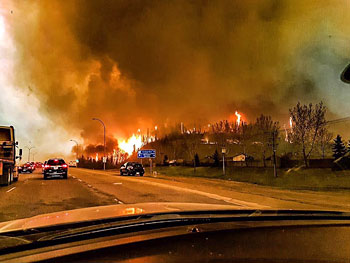
From: Tim Newstead, Bourton-on-the-Water
Subject: Thinking of those affected by the Fires
Hi Tony,
I see from MAMS OBA Earth that there are no members pinned in or around Fort McMurray; nevertheless, perhaps there are friends or relatives of members affected by the dreadful fire in Alberta. Just a note to say that we are thinking of all those affected - friends and ex-colleagues, both known and unknown - and hope that folk are able to stay safe and, in the future, rebuild.
Kind regards, Tim
Subject: Thinking of those affected by the Fires
Hi Tony,
I see from MAMS OBA Earth that there are no members pinned in or around Fort McMurray; nevertheless, perhaps there are friends or relatives of members affected by the dreadful fire in Alberta. Just a note to say that we are thinking of all those affected - friends and ex-colleagues, both known and unknown - and hope that folk are able to stay safe and, in the future, rebuild.
Kind regards, Tim
From: Jim Rice, Fareham, Hants
Subject: Junior Officer Mishaps
Hi Tony,
I have written a piece for the "Junior Officers Mishaps" topic and as it has some interesting info on air drops at Port Stanley I thought I would amalgamate the two. Also, I have found a photo on line which I'm sure many people have seen before of the very low C130 at Stanley. I haven't made my mind up whether it's real or not, probably someone may have the answer.
During our time at Port Stanley, after things started to get back to some normality, a huge task of great importance was to repair the pan area and lengthen the runway. This job fell to the Field Engineer Regiments, including the Gurkhas, who all worked around the clock, 3 hours on and 9 hours off, laying the thousands of sheets of AMS matting. The task of laying the new runway became a very competitive one and was finished two days ahead of schedule, which entailed a lot of crates being consumed by the winning teams.
During this period the Hercules maintained a regular service to airdrop supplies and to collect the mail. Collecting the mail took some planning, and after some head scratching by the boys at the Joint Air Transport Establishment (JATE) at Brize Norton, they came up with the "Snatch Method". This comprised of a grappling hook attached to a 150 foot long nylon rope being trailed behind the aircraft attached to a winch operated by 47 Air Despatch guys in the back.
Subject: Junior Officer Mishaps
Hi Tony,
I have written a piece for the "Junior Officers Mishaps" topic and as it has some interesting info on air drops at Port Stanley I thought I would amalgamate the two. Also, I have found a photo on line which I'm sure many people have seen before of the very low C130 at Stanley. I haven't made my mind up whether it's real or not, probably someone may have the answer.
During our time at Port Stanley, after things started to get back to some normality, a huge task of great importance was to repair the pan area and lengthen the runway. This job fell to the Field Engineer Regiments, including the Gurkhas, who all worked around the clock, 3 hours on and 9 hours off, laying the thousands of sheets of AMS matting. The task of laying the new runway became a very competitive one and was finished two days ahead of schedule, which entailed a lot of crates being consumed by the winning teams.
During this period the Hercules maintained a regular service to airdrop supplies and to collect the mail. Collecting the mail took some planning, and after some head scratching by the boys at the Joint Air Transport Establishment (JATE) at Brize Norton, they came up with the "Snatch Method". This comprised of a grappling hook attached to a 150 foot long nylon rope being trailed behind the aircraft attached to a winch operated by 47 Air Despatch guys in the back.
A C130 overflies the mail snatch location while a young Army captain places himself in peril taking photographs.
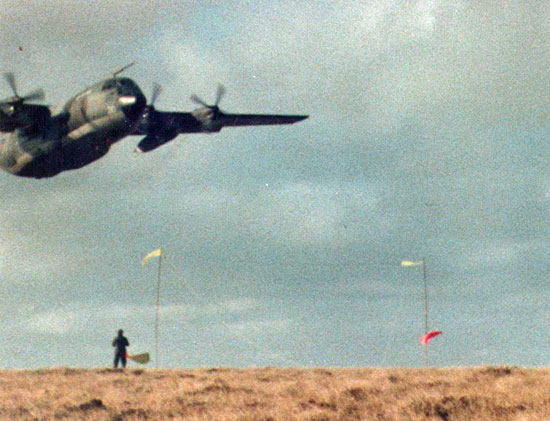
The low-flying Hercules at Stanley (see notes at the end of the article).
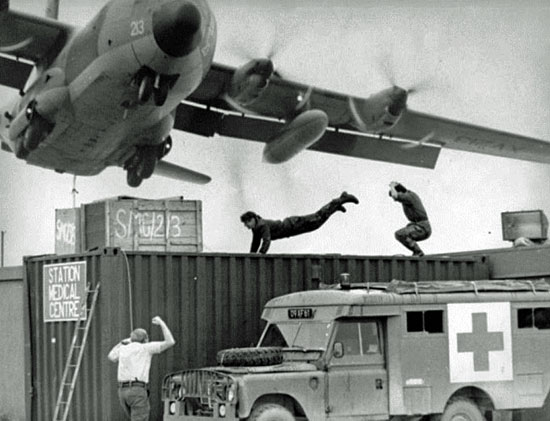
After trying to explain how dangerous it was up at the pick up zone, there was no stopping him. I managed to take the photograph of the snatch with our friend standing right next to the post, which I estimated to be around 20 feet away from the actual point of the snatch. Bearing in mind that at times the Hercules didn’t make contact on the first pass and would go around again, he was a very fortunate young officer. I just hope he took some good photos!
I never gave it much thought at the time, but even as MAMS rivals I take my hat off to those 47 AD lads in the back of the Hercules doing those long return runs from Ascension.
Jim
(Regarding the photo of the low-flying Hercules. I suspect that this could be a photo that the young Army captain took. The aircraft ramp is open, gear and flaps extended, and a rope with a marker on it hanging out of the back. Some enterprising chap has Photoshopped it into the scenario.)
I never gave it much thought at the time, but even as MAMS rivals I take my hat off to those 47 AD lads in the back of the Hercules doing those long return runs from Ascension.
Jim
(Regarding the photo of the low-flying Hercules. I suspect that this could be a photo that the young Army captain took. The aircraft ramp is open, gear and flaps extended, and a rope with a marker on it hanging out of the back. Some enterprising chap has Photoshopped it into the scenario.)
The equipment on the ground comprised of two poles (goal posts) 20 foot high and 50 feet apart, with a loop attached and 50lb breaking strength parachute cord running between the posts and another nylon rope 150 feet along the ground attached to the mail bag approx 45kg in weight.
Markers were set up at 300 and 600 foot distance to the approach and the aircraft, flying at a height of 50 feet above the ground, would hopefully pick up the looped rope with the grappling hook, snatching the mail.
As the aircraft passed at 50 feet, travelling at around 150mph you could hear the WHOOSH as the hook passed, and I don’t think anyone told the 47 AD lads that the Falklands do not have the terrain of a billiard table. The terrain at Seal Point was in fact very undulated with lots of small hills, barbed wire and sheep. With this in mind we found ourselves a nice ditch with a good distance between us and the snatch point, and of course a good view of the proceedings as I had my small camera with me.
At this point we were approached by a young Army captain who seemed very keen to learn what we were doing. After we explained what was about to happen he very excitedly got out his expensive camera and said, "I'm going up to get a good shot of this, anyone coming?"
Markers were set up at 300 and 600 foot distance to the approach and the aircraft, flying at a height of 50 feet above the ground, would hopefully pick up the looped rope with the grappling hook, snatching the mail.
As the aircraft passed at 50 feet, travelling at around 150mph you could hear the WHOOSH as the hook passed, and I don’t think anyone told the 47 AD lads that the Falklands do not have the terrain of a billiard table. The terrain at Seal Point was in fact very undulated with lots of small hills, barbed wire and sheep. With this in mind we found ourselves a nice ditch with a good distance between us and the snatch point, and of course a good view of the proceedings as I had my small camera with me.
At this point we were approached by a young Army captain who seemed very keen to learn what we were doing. After we explained what was about to happen he very excitedly got out his expensive camera and said, "I'm going up to get a good shot of this, anyone coming?"
Under the Glide Path - RAF Waddington
Bring a deck chair, some sandwiches and a thermos of tea and settle down to watch some aircraft movements under the glide path at Waddington.
Canberra
Rivet Joint
F-16
A400M
727
F-18
Hawker Hunter
Typhoon
Saab Draken
Saab Viggen
Vulcan
Rivet Joint
F-16
A400M
727
F-18
Hawker Hunter
Typhoon
Saab Draken
Saab Viggen
Vulcan
From: Richard Lloyd, Dalgety Bay, Fife
Subject: Assume the Position
Dear Tony,
Thanks so much for another much-anticipated issue of UKMAMSOBA Old Bods Briefs, and many thanks for the very considerable work you put in every month!
In 1968, I was a DAMO at RAF Northolt. My boss was a very pleasant Scottish Flt Lt, George McElroy by name.
George fell ill and of the three Pilot Officer DAMOs, I was deemed to be the most senior and ran the Station Movements operation for some months until power was wrested from my unwilling hands by Flt Lt Peter Hilton, by which time I had been promoted to Flying Officer.
Here's a contemporary picture for those who like that sort of thing! I am in conversation with customs officer Reg Duffield as we meet an Italian Air Force C119.
Richard
Subject: Assume the Position
Dear Tony,
Thanks so much for another much-anticipated issue of UKMAMSOBA Old Bods Briefs, and many thanks for the very considerable work you put in every month!
In 1968, I was a DAMO at RAF Northolt. My boss was a very pleasant Scottish Flt Lt, George McElroy by name.
George fell ill and of the three Pilot Officer DAMOs, I was deemed to be the most senior and ran the Station Movements operation for some months until power was wrested from my unwilling hands by Flt Lt Peter Hilton, by which time I had been promoted to Flying Officer.
Here's a contemporary picture for those who like that sort of thing! I am in conversation with customs officer Reg Duffield as we meet an Italian Air Force C119.
Richard
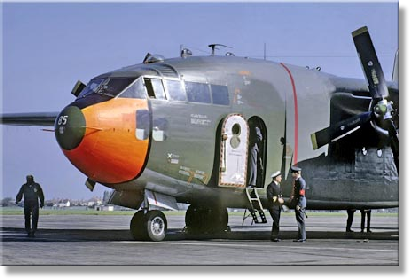
From: David Powell, Princes Risborough
Subject: Assume the Position
Hi Tony,
Not so much a take over but a memorable hand over situation. One of my UKMAMS Abingdon punishment tasks was to go out to New York as the resident mover's number two to fill in for a couple of months after the establishment was increased to handle the switch from sea trooping to air trooping by VC10 for postings and detachments of MoD Military and Civilians and dependents.
At JFK most of the day to day interaction out on the ramp was with a select breed of New Yorkers. Almost all 4' 2", with thick 'doity doid an doid' Brooklyn accents. That phrase meant the junction between 33 Street and Third Avenue in Manhattan.
Well my permanent successor was an example of a careful Air Sec's selection process of the highest level. Their solution was a wee 6' 6" MacMover from Glasgow. Not only could neither party understand each other - but, especially against a background of ground power units, ACHE and aircraft engines, they couldn't even lip read!
Best wishes to all
David Powell
F Team UKMAMS 1967-69
Subject: Assume the Position
Hi Tony,
Not so much a take over but a memorable hand over situation. One of my UKMAMS Abingdon punishment tasks was to go out to New York as the resident mover's number two to fill in for a couple of months after the establishment was increased to handle the switch from sea trooping to air trooping by VC10 for postings and detachments of MoD Military and Civilians and dependents.
At JFK most of the day to day interaction out on the ramp was with a select breed of New Yorkers. Almost all 4' 2", with thick 'doity doid an doid' Brooklyn accents. That phrase meant the junction between 33 Street and Third Avenue in Manhattan.
Well my permanent successor was an example of a careful Air Sec's selection process of the highest level. Their solution was a wee 6' 6" MacMover from Glasgow. Not only could neither party understand each other - but, especially against a background of ground power units, ACHE and aircraft engines, they couldn't even lip read!
Best wishes to all
David Powell
F Team UKMAMS 1967-69
Rededication of 36 Squadron's Standard
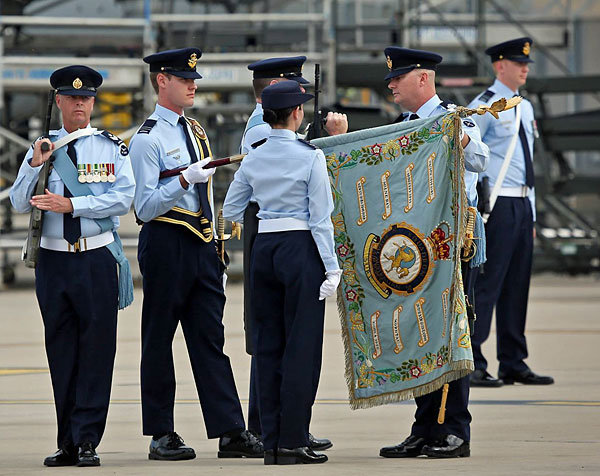
On Thursday 19 May 2016, No 36 Squadron held a military parade at RAAF Amberley in Queensland for the rededication of their Squadron Standard.
The Standard was originally awarded on 1 April 1971 in recognition of a quarter-century's dedicated service to the sovereign and nation.
The Squadron Standard was replaced and rededicated to the Squadron by the Governor-General, His Excellency General the Honourable Sir Peter Cosgrove AK MC (Retd).
(The picture of the Warrant Officer is none other than our very own OBA member David Sheen)
Lifted from Facebook
The Standard was originally awarded on 1 April 1971 in recognition of a quarter-century's dedicated service to the sovereign and nation.
The Squadron Standard was replaced and rededicated to the Squadron by the Governor-General, His Excellency General the Honourable Sir Peter Cosgrove AK MC (Retd).
(The picture of the Warrant Officer is none other than our very own OBA member David Sheen)
Lifted from Facebook
From: Andrew Finlayson, Adelaide, SA
Subject: Assume the Position
One cold February morning in 1972 I was hanging around with the day shift in the warmth of DAMO’s office after finishing a night shift at RAF Lyneham before facing defrosting the windscreen and driving home. The squadron commander came in and announced, “anyone fancy a fortnight in the sun?”
Almost without a second thought and ignoring the timeless advice to never volunteer I heard myself say, “Where to?” To which he replied that it was a place called RAF Masirah (which I’d never heard of ) an island in the Indian Ocean where the #2 Movements Officer had been taken ill and ‘casevaced’ back to the UK and where consequently they needed someone to stand in for a couple of weeks until a replacement was found. This sounded to my ears like a gift from above. Visions of palm trees, warm tropical waters, sipping tall drinks poolside and other such fantasies floated in the air. Clearly my boss had found his quarry.
“OK, get home, pack your KDs and be back here in an hour for your flight.”
I raced home, left a note for the wife ( of five months) saying “Gone for a couple of weeks, duty I’m afraid.” Or words to that effect, packed and within a couple of hours I was in the back of a C130 en route to Masirah, wherever that was. To my horror the ‘tropical island’ was simply a rock sticking out of the sea and covered in sand. Instead of streets lined with tourists, cocktail bars and beaches scattered with sun beds there was just a motley assortment of blokes, sweating away in the desert heat. Three weeks later, feeling slightly forgotten I signalled back to Lyneham. “Finlayson here, where is my relief?”
I have omitted to mention that at this time Lyneham was blessed with a Movements Wing and consequently this signal found its way to the Wing Commander’s desk. Back came a reply: “ What relief? Soldier on.” Our Wing Commander possessed a somewhat irascible personality and I was therefore disinclined to prolong the exchange of ideas about my secondment so I did as I was bid and soldiered on.
It turned out to be the best posting in my whole service career. There were more bars on that island than I ever could count. I recall that in the absence of much else to do people perfected their expertise in whatever interest they had. One person in the mess for example could sing the whole of Nellie Dean backwards standing on his head. This might give you an idea of the amount of time we had on our hands. Plus we had the chance to regularly visit the duty free port of Dubai courtesy of the Andover ‘milk run’ and fill our little cases with the duty free goodies from the electronic stores and the trinkets from the souk. It was a little different from the Dubai of today. For example to get to one of the aforesaid electronic stores you were taken across a river by a gentleman in flowing robes who steered the wooden boat with his foot. A little unnerving when you are clinging on to your Sanyo tuner on the return trip.
There was never a dull moment working there whether you were chasing camels off the runway, trying your hand at marshalling a Britannia, towing steps or gingerly approaching cargo doors with a forklift. And because the station was officially his property just stepping aside so the local sheik guarded by two Lee Enfield bearing security men, again in flowing robes adorned with beautiful decorative Janbiya curved daggers could come in and inspect his passenger lounge.
I can still remember most of the people on the Movements Flight and I have a picture to refer to which brings it all back and the fun we had together on that baking hot rock. I’m not in it so I assume that it was taken when my relief finally arrived.
Subject: Assume the Position
One cold February morning in 1972 I was hanging around with the day shift in the warmth of DAMO’s office after finishing a night shift at RAF Lyneham before facing defrosting the windscreen and driving home. The squadron commander came in and announced, “anyone fancy a fortnight in the sun?”
Almost without a second thought and ignoring the timeless advice to never volunteer I heard myself say, “Where to?” To which he replied that it was a place called RAF Masirah (which I’d never heard of ) an island in the Indian Ocean where the #2 Movements Officer had been taken ill and ‘casevaced’ back to the UK and where consequently they needed someone to stand in for a couple of weeks until a replacement was found. This sounded to my ears like a gift from above. Visions of palm trees, warm tropical waters, sipping tall drinks poolside and other such fantasies floated in the air. Clearly my boss had found his quarry.
“OK, get home, pack your KDs and be back here in an hour for your flight.”
I raced home, left a note for the wife ( of five months) saying “Gone for a couple of weeks, duty I’m afraid.” Or words to that effect, packed and within a couple of hours I was in the back of a C130 en route to Masirah, wherever that was. To my horror the ‘tropical island’ was simply a rock sticking out of the sea and covered in sand. Instead of streets lined with tourists, cocktail bars and beaches scattered with sun beds there was just a motley assortment of blokes, sweating away in the desert heat. Three weeks later, feeling slightly forgotten I signalled back to Lyneham. “Finlayson here, where is my relief?”
I have omitted to mention that at this time Lyneham was blessed with a Movements Wing and consequently this signal found its way to the Wing Commander’s desk. Back came a reply: “ What relief? Soldier on.” Our Wing Commander possessed a somewhat irascible personality and I was therefore disinclined to prolong the exchange of ideas about my secondment so I did as I was bid and soldiered on.
It turned out to be the best posting in my whole service career. There were more bars on that island than I ever could count. I recall that in the absence of much else to do people perfected their expertise in whatever interest they had. One person in the mess for example could sing the whole of Nellie Dean backwards standing on his head. This might give you an idea of the amount of time we had on our hands. Plus we had the chance to regularly visit the duty free port of Dubai courtesy of the Andover ‘milk run’ and fill our little cases with the duty free goodies from the electronic stores and the trinkets from the souk. It was a little different from the Dubai of today. For example to get to one of the aforesaid electronic stores you were taken across a river by a gentleman in flowing robes who steered the wooden boat with his foot. A little unnerving when you are clinging on to your Sanyo tuner on the return trip.
There was never a dull moment working there whether you were chasing camels off the runway, trying your hand at marshalling a Britannia, towing steps or gingerly approaching cargo doors with a forklift. And because the station was officially his property just stepping aside so the local sheik guarded by two Lee Enfield bearing security men, again in flowing robes adorned with beautiful decorative Janbiya curved daggers could come in and inspect his passenger lounge.
I can still remember most of the people on the Movements Flight and I have a picture to refer to which brings it all back and the fun we had together on that baking hot rock. I’m not in it so I assume that it was taken when my relief finally arrived.
I cannot conclude a story about Masirah without describing the township that lay just outside the camp. It was constructed entirely of oil drums and the romantic tale was that this was because of a curse laid upon them by the Sheik that they were not allowed to ‘place stone upon stone’. Well, we believed it anyway.
We were blessed with a remarkably decent CO who, whilst keeping a very disciplined station, displayed great patience with a very callow junior officer. Having said that, additional periods of Station Orderly Officer were administered from time to time, entirely appropriately it must be said.
My impetuous reaction to the offer of two weeks winter sunshine, although it appeared to backfire badly, led to the best months of my six year RAF career.
Oh, and for the record, in case anyone recognises him that Wing Commander was one of the most professional people I have met in any walk of life and he taught me more than anyone else in the RAF or since. That doesn’t mean that I had to like it of course.
All the best,
Andrew
We were blessed with a remarkably decent CO who, whilst keeping a very disciplined station, displayed great patience with a very callow junior officer. Having said that, additional periods of Station Orderly Officer were administered from time to time, entirely appropriately it must be said.
My impetuous reaction to the offer of two weeks winter sunshine, although it appeared to backfire badly, led to the best months of my six year RAF career.
Oh, and for the record, in case anyone recognises him that Wing Commander was one of the most professional people I have met in any walk of life and he taught me more than anyone else in the RAF or since. That doesn’t mean that I had to like it of course.
All the best,
Andrew
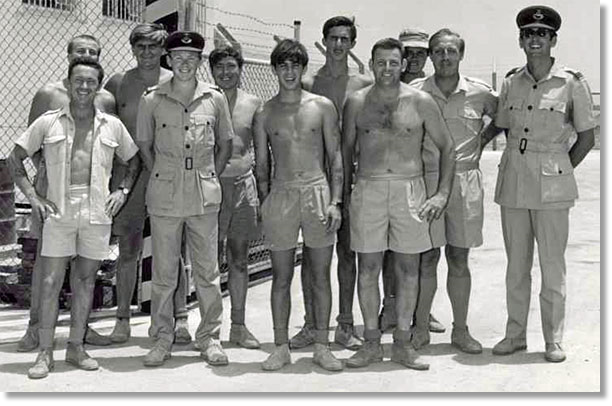
I recognise Dave Cromb and Roy Millington - can anyone identify the rest?
(Footnote: The then Wing Commander, ultimately Group Captain, was David Owens, sadly passed now. He was a fearsome boss who quite literally forced me to grow up. I have more than a few embarrassing memories of how he made me confront my bumbling incompetence. As a sulky, spoiled twenty three year old you can imagine I did not take kindly to being made to become an adult. I did get a chance to thank him though, many years later at a Movers Reunion at the RAF Club the penny having then dropped, for the enormous favour he had done me. I am tempted to repeat a cliché because it is in this case strikingly true that they don’t make ‘em like that anymore.)
From: Ian Berry, West Swindon, Wilts
Subject: Visit to an old friend
Hi Tony,
I've just returned from 10 days in Florida and spent three away from Orlando and drove up to Pensacola to visit the US Naval Aviation Museum.
I stayed with my good old friend Frank Johnston (ex-MAMS Eng) and his wife Janet and so he also took me to see the gate guardians at Hulbert Field and Eglin AFB.
Regards
Ian
Subject: Visit to an old friend
Hi Tony,
I've just returned from 10 days in Florida and spent three away from Orlando and drove up to Pensacola to visit the US Naval Aviation Museum.
I stayed with my good old friend Frank Johnston (ex-MAMS Eng) and his wife Janet and so he also took me to see the gate guardians at Hulbert Field and Eglin AFB.
Regards
Ian
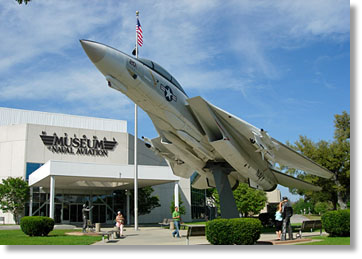
From: Bruce Holliday, Beccles, Suffolk
Subject: Corporate Aftermath - Shutting up Shop
Hi Tony,
Attached a short piece 'Shutting up Shop' for your consideration for "Corporate Aftermath". As you know I'm not a Mover myself but there's some interesting photos for those who were there
June 1985, I was nearing the end of my first detachment as a young Junior Technician TG3 attached to Ground Radio Flight, RAF Stanley. I'd spent 3 months at Stanley before moving to Mount Pleasant (MPA), as it was then classed as an airfield and not a complex! I'd enjoyed every single moment and memories are as vivid now over 30 years later.
I moved to MPA with Taff Robins and my old friend Frank Cook as Stanley was closing and we still had too many 'days to do' and I was some way from getting my FOG badge. I was given this set of photos by the guy of GRF Stanley who stayed behind to help dismantle and RTU the airfield nav aids.
Subject: Corporate Aftermath - Shutting up Shop
Hi Tony,
Attached a short piece 'Shutting up Shop' for your consideration for "Corporate Aftermath". As you know I'm not a Mover myself but there's some interesting photos for those who were there
June 1985, I was nearing the end of my first detachment as a young Junior Technician TG3 attached to Ground Radio Flight, RAF Stanley. I'd spent 3 months at Stanley before moving to Mount Pleasant (MPA), as it was then classed as an airfield and not a complex! I'd enjoyed every single moment and memories are as vivid now over 30 years later.
I moved to MPA with Taff Robins and my old friend Frank Cook as Stanley was closing and we still had too many 'days to do' and I was some way from getting my FOG badge. I was given this set of photos by the guy of GRF Stanley who stayed behind to help dismantle and RTU the airfield nav aids.
"Penguin Radar" was a Mobile Airfield Radar Installation - AR1 sited across the runway from GRF which itself was some 200/300 yards east of the control tower, right next to the first 1000lb bomb crater I'd ever seen courtesy of Black Buck.
We were sited in amongst a rock outcrop and many a Landover met an untimely end as we time trialled getting from the edge of the PSP runway to the hard standing outside the radar cabin door. The radar was still in use to the end of May and had guided the Phantoms based at Stanley and seen the trooper arrive from Ascension. Much of the flying was now based at MPA and therefore most air traffic services were based there but as this AR1 had a longer range display, 100 miles, and so it remained operational almost to the end. Many a gozome bird was watched with great anticipation from 100 miles out all the way to the runway.
By late May/early June MPA provided all the air traffic services and Penguin Radar was retired. The radar was uplifted and was to be returned to the UK. These are a few pictures of the air lifting by Chinook.
Regards,
Bruce
We were sited in amongst a rock outcrop and many a Landover met an untimely end as we time trialled getting from the edge of the PSP runway to the hard standing outside the radar cabin door. The radar was still in use to the end of May and had guided the Phantoms based at Stanley and seen the trooper arrive from Ascension. Much of the flying was now based at MPA and therefore most air traffic services were based there but as this AR1 had a longer range display, 100 miles, and so it remained operational almost to the end. Many a gozome bird was watched with great anticipation from 100 miles out all the way to the runway.
By late May/early June MPA provided all the air traffic services and Penguin Radar was retired. The radar was uplifted and was to be returned to the UK. These are a few pictures of the air lifting by Chinook.
Regards,
Bruce
From: Graham Allen, Nottingham
Subject: Assume the position!
Hi Tony,
We were doing an "Off base task" at Gatwick airport and the ground handling was being done by BA. They had seen the first two VC10's off and then shot off for their breakfast.
An hour later the last VC10 had to return due to tech issues. We couldn't find any of the BA team to bring the aircraft back on to the stand. The young DAMO was now hypertheically flying at 40,000 and still climbing and said what are we going to do?.
No problem I said, picked up the bats and brought the aircraft back onto the stand. I spoke to the Sqn Ldr who was the captain and he thanked me as he was advised that the BA crew could not be contacted. He asked me how long I had been able to bring aircraft onto stands. He was gobsmacked when I told him that was the first time I had done it.
Young DAMO passed out when he heard! I had seen it done a few times and just kept a cool head. Got a "Very well done" from all the crew; the BA crew waltzed up and wanted to know if the aircraft captain had just parked it himself. Captain explained that I did it and I was advised there was a job for me working at BA if I wanted! It was just having the confidence to step up to the plate when required and by the end of the week I had bought a further 6 aircraft onto the stand
Graham Allen
Subject: Assume the position!
Hi Tony,
We were doing an "Off base task" at Gatwick airport and the ground handling was being done by BA. They had seen the first two VC10's off and then shot off for their breakfast.
An hour later the last VC10 had to return due to tech issues. We couldn't find any of the BA team to bring the aircraft back on to the stand. The young DAMO was now hypertheically flying at 40,000 and still climbing and said what are we going to do?.
No problem I said, picked up the bats and brought the aircraft back onto the stand. I spoke to the Sqn Ldr who was the captain and he thanked me as he was advised that the BA crew could not be contacted. He asked me how long I had been able to bring aircraft onto stands. He was gobsmacked when I told him that was the first time I had done it.
Young DAMO passed out when he heard! I had seen it done a few times and just kept a cool head. Got a "Very well done" from all the crew; the BA crew waltzed up and wanted to know if the aircraft captain had just parked it himself. Captain explained that I did it and I was advised there was a job for me working at BA if I wanted! It was just having the confidence to step up to the plate when required and by the end of the week I had bought a further 6 aircraft onto the stand
Graham Allen
That's it for this edition
Have a great weekend!
Best regards
Tony
ukmamsoba@gmail.com
Have a great weekend!
Best regards
Tony
ukmamsoba@gmail.com









